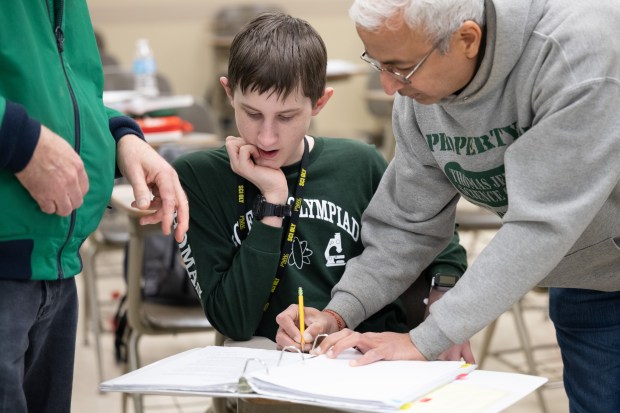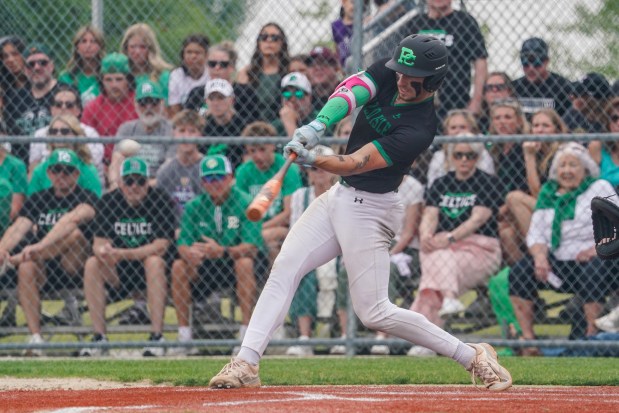If Chris Fisher had a nickel for every time he came downstairs and found his eighth-grade sons’ vehicle smashed to bits because something wasn’t working right, he’d have been able to buy them one they didn’t have to repair several times over.
“This thing has been wrecked at least 20 times; was a year’s worth of work at least,” Fisher said as his boys, Brad and Nathan, debriefed after they finished their event, “Wheeled Vehicle,” during the Indiana Science Olympiad’s state competition at Purdue Northwest Saturday afternoon.
The goal was to create a vehicle that could be powered 8 to 12 meters using household objects and math, and the two, in their first time competing in the event, got theirs go 1.18 meters in 5.32 seconds and 66 centimeters in 4.63 seconds.
“We started off with completely different parts before we got to this one,” Brad said. “I think we made the top three.”
“I set up our basement with a 12-meter course and would give them random distances to meet,” Chris Fisher said. “I think you guys made top eight easily.”
The top 24 teams in the state converged on the campus yesterday for the second year of PNW hosting the state tournament, including 17 teams from Lake and Porter counties, PNW Associate Dean of Engineering and Science Olympiad state director Vanessa Quinn said. The top high school and middle school teams will head to the national competition in Lansing, Michigan later this spring.
The top four high schools coming out of state are as follows: Carmel in first place, Munster in second, Lake Central in third and Northridge in fourth, while the top middle schools were Thomas Jefferson in Valparaiso in first, Wilbur Wright in Munster in second, Raymond Park in third and Tri-North in fourth, PNW Spokesman Kale Wilk said Sunday. It’s also Thomas Jefferson’s 31st time winning state and qualifying for nationals.

Individual high school winners had a lot at stake as well since PNW offered a $500 scholarship to the school for those who earned first-place wins, Quinn said. Since high schoolers have mostly competed for several years and they’re truly the “best of the best,” she fully expected several kids to walk out of the competition with $1,500 — $500 for each event, up to three events.
The kids winning first place in astronomy events were also awarded eclipse glasses, she said.
Quinn’s favorite thing about having the state competition at PNW, however, remains the fact that for a lot of the younger kids competing, it’s their first time on a college campus. They’re seeing university labs and working with professors and college students in a setting that’s not completely overwhelming like it can be at the bigger campuses.
“This is the perfect-sized campus to run this event, so the kids feel like, “You know, college is something I can do,” Quinn said.

The TJ kids were feeling pretty good about their chances around lunchtime, even if they didn’t remember all the details. Valparaiso freshman Caroline Dyer, who was invited back to compete one last time with the team, shaded in an anime cartoon she drew while decompressing.
“In Crime Busters, we identified unknown powders and liquids while using a crime scenario (one of the professors made up), and it was some guy who stole something from another guy, and there was something with an ‘L,’” she said.
Ryan Allred, a sixth grader, joined the team after his teacher, coach Carol Haller, told him he would be great on the team. He and his partner, Albert Duncan, competed in Roller Coaster, where they had to – you guessed it – build a roller coaster and have a marble complete its path.
“I’m not typically the building type, but I’ve liked this experience, plus it was good to feel wanted, so I tried out and made the team,” Ryan said. “All the hard work paid off.”
His brother, eighth grader Nathan Allred, however, has a couple years on Ryan, and isn’t afraid to remind him, though he’s a bit more humble about it lately.
“I’m on a streak of not bringing up my first places in weeks now,” he said.
Michelle L. Quinn is a freelance reporter for the Post-Tribune.





